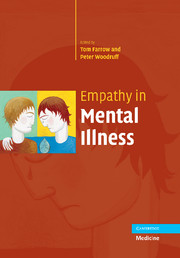Book contents
- Frontmatter
- Contents
- Foreword
- List of contributors
- Part I ‘Dysempathy’ in psychiatric samples
- Part II Empathy and related concepts in health
- 9 Neonatal antecedents for empathy
- 10 The evolutionary neurobiology, emergence and facilitation of empathy
- 11 Naturally occurring variability in state empathy
- 12 Neuroimaging of empathy
- 13 The neurophysiology of empathy
- 14 The cognitive neuropsychology of empathy
- 15 The genetics of empathy and its disorders
- 16 Empathogenic agents: their use, abuse, mechanism of action and addiction potential
- 17 Existential empathy: the intimacy of self and other
- 18 Empathizing and systemizing in males, females and autism: a test of the neural competition theory
- 19 Motivational-affective processing and the neural foundations of empathy
- 20 Face processing and empathy
- Part III Empathy models, regulation and measurement of empathy
- Index
9 - Neonatal antecedents for empathy
from Part II - Empathy and related concepts in health
Published online by Cambridge University Press: 17 August 2009
- Frontmatter
- Contents
- Foreword
- List of contributors
- Part I ‘Dysempathy’ in psychiatric samples
- Part II Empathy and related concepts in health
- 9 Neonatal antecedents for empathy
- 10 The evolutionary neurobiology, emergence and facilitation of empathy
- 11 Naturally occurring variability in state empathy
- 12 Neuroimaging of empathy
- 13 The neurophysiology of empathy
- 14 The cognitive neuropsychology of empathy
- 15 The genetics of empathy and its disorders
- 16 Empathogenic agents: their use, abuse, mechanism of action and addiction potential
- 17 Existential empathy: the intimacy of self and other
- 18 Empathizing and systemizing in males, females and autism: a test of the neural competition theory
- 19 Motivational-affective processing and the neural foundations of empathy
- 20 Face processing and empathy
- Part III Empathy models, regulation and measurement of empathy
- Index
Summary
Introduction
To properly address the concept of empathy during infancy, developmental theorists must first define empathy, keeping in mind the resources of infants. Rather most theorists focus on the limitations when referring to empathy during infancy. For example, normal functioning infants have been described as dysregulated, less-than-conscious, egocentric and too immature in their representational and self-other capacities to experience empathy (Eisenberg, 1989; Kiang et al., 2004; Strayer, 1987). It is disheartening to think that newborns must be considered inept, rather than simply developing or evolving. Further these definitions indicate an insufficient understanding of infancy and the way that the brain forms during development.
Intuitively it is assumed that emotions are ubiquitous during infancy (Fox, 1991). While it is obvious that newborns do not have the cognitive and experiential abilities required for fully developed forms of empathy, human beings are equipped to function emotionally from birth and emotionality is a key component of evolving empathy.
Studies have shown that newborns can imitate, discriminate and display many of the primary emotions (Field et al., 1982). Findings from these studies suggest that individuals are born with the dispositional tendency to be alerted by emotion signals and that individual infants differentially respond to these signals (Jones et al., 1997b). Brothers (1989) has even suggested that newborn imitation of emotions is a signal for the capacity for empathy (in some precursor form) in the normal brain, one that is elaborated by cognitive maturation and social experiences.
- Type
- Chapter
- Information
- Empathy in Mental Illness , pp. 145 - 167Publisher: Cambridge University PressPrint publication year: 2007
- 2
- Cited by



